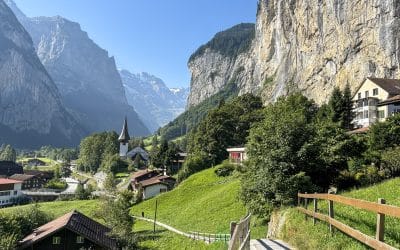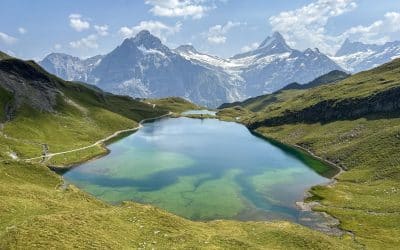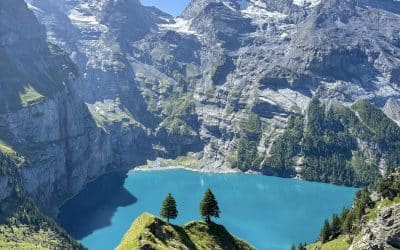Explore the Zermatt Five Lakes Hike with this practical trail guide: route options, lift details, best spots, and what to expect at each lake.

If you’ve ever scrolled through photos of Zermatt and thought, that reflection of the Matterhorn can’t be real, it probably came from this hike. The Five Lakes Hike (or 5-Seenweg, if you want to sound local) is the trail that everyone with a camera, decent shoes, and a free morning ends up doing. And it’s because it’s scenic, relatively easy to follow, and packed with photo stops that don’t require mountain-goat stamina.
This guide breaks it all down: how to get there, where to start, what to skip, and how long it actually takes when you’re not rushing for the next train.
- Looking for more exceptionally beautiful trails in the country? You’ll love this guide to the best hikes in Switzerland
How to Get To The Five Lakes Hike in Zermatt
Everything starts in Zermatt, a car-free village you can only reach by train. If you’re driving, you’ll need to leave your car in Täsch, the last town before Zermatt, and continue on the Matterhorn Gotthard Bahn, a small shuttle train that runs every 20 minutes. The ride takes about 12 minutes and costs CHF 8.20 one way (CHF 16.40 return).
If you’re coming by public transport, trains connect Visp and Brig to Zermatt all day long, and both are major stops on the main Swiss rail line between Bern and Milan. The final stretch up the valley is spectacular on its own, especially if you grab a window seat on the right side.
From Zermatt station, it’s a short walk (about 5 minutes) to the Sunnegga funicular valley station, where the ascent begins. The funicular climbs straight through the mountain and ends at the Sunnegga funicular upper station, your trailhead. A one-way ticket to Sunnegga costs around CHF 22 (CHF 33 return).
From here, you’ve got two ways to approach the trail:
Option 1 – Full Loop (Funicular Only)
Start walking directly from Sunnegga upper station. This version covers the full 11 km loop and includes the uphill section to Leisee and Stellisee. It’s steeper at the start, but you skip the extra lift and get a quieter, more rewarding climb before joining the main 5-Seenweg trail.
Option 2 – Easier Start (Funicular + Gondola)
If you’d rather focus on the lakes than the climb, take the additional gondola from Sunnegga up to Blauherd station. The combined funicular + gondola ticket costs around CHF 36 one way (CHF 52 return). This shortcut drops you right at altitude, where the “official” Five Lakes Walk begins. From Blauherd, it’s mostly downhill, smoother, faster, and what most hikers (and every tour group) choose.

Five Lakes Trail Stats
Full Trail Loop
- Type: Loop
- Start & end point:Sunnegga funicular upper station
- Distance: 11 km / 6.8 miles
- Hiking time: 4.5 hours
- Elevation gain: + 440 m / +1445 ft
- Difficulty: moderate due to the initial uphill hike
- AllTrails map
Shorter Walk With Partial Loop
- Type: Point-to-point / Partial loop
- Start point: Blauherd station
- End poin: Sunnegga funicular upper station
- Distance: about 9.6 km / 5.8 miles
- Hiking time: 3.5 hours
- Elevation gain: +240 m / +790 ft
- Difficulty: easy, mostly downhill with rocky sections
- AllTrails map
Five Lakes Walk Hiking Map
Visual reference helps more than any description. Here’s the full walk plotted out:

Five Lake Walk Overview
As already mentioned, the Five Lakes Hike (5-Seenweg) runs from Blauherd to Sunnegga, but you can also hike it as a complete loop from Sunnegga, which adds a steeper first hour and roughly 1.7 km to the route. Whether it’s worth doing that part depends on your legs and your curiosity.
Sunnegga to Blauherd (Pre-trail Section)
If you skip the gondola and start from Sunnegga funicular upper station, the first section climbs steadily through alpine pasture toward Blauherd. The trail is well-marked and mostly gravel, occasionally cutting through larch woods. You’ll pass a few wooden animal sculptures — part of the “Wolli Adventure Trail,” technically for kids but surprisingly charming — and wide-open views of the Matterhorn appear early on.
The higher you get, the better the Matterhorn views, especially as you approach Fluhalp hut, a mountain restaurant just above Blauherd that’s perfect for coffee before you hit the lakes.



Lake #1: Stellisee
This is where the postcards come from. Stellisee sits perfectly beneath the Matterhorn, with the reflection you’ve seen a thousand times online, except in person it’s still absurdly good. The path circles the lake clockwise, and if the wind is calm, you’ll get a flawless mirror shot. Mornings are best; by late afternoon, the reflection usually blurs.
There are benches and a few grassy spots for early lunch breaks.



Lake #2: Grindjisee
After Stellisee, the trail drops gently through meadows and a stand of larches to Grindjisee.
The lake itself is irregularly shaped, framed by reeds and trees, and shaded enough to feel secret. The Matterhorn appears between the trees like it’s posing. Expect relative quiet here, as many hikers rush ahead. This is a great place to sit and actually hear the alpine silence again after the crowds at Stellisee. There’s a small wooden bridge at the outlet with one of the nicest angles for Matterhorn views.
Lake #3: Grünsee
Leaving Grindjisee, the path turns rockier and more uneven as you descend toward Grünsee. You’ll start to see patches of forest, then the lake suddenly opens up in a wide basin. Its name means “green lake,” but on sunny days it glows turquoise. The shore is open and flat, making it the only lake suitable for a spontaneous swim, and locals do it even when the water’s freezing. There’s also a mountain hut nearby, Grünsee Restaurant, just a few minutes uphill on the right, serving basic alpine food and cold drinks. It’s the best place on the trail to sit down for lunch with a view.



Lake #4: Moosjisee
Between Grünsee and Moosjisee, the landscape changes completely: less wild, more technical. The trail cuts across a slope with some gravel switchbacks before you reach the milky turquoise reservoir. It’s an artificial lake used for snowmaking, so not postcard-pretty, but it’s oddly fascinating. The color comes from suspended glacial dust, and the contrast with the dark cliffs makes it worth a short stop.
Lake #5: Leisee
The final section from Moosjisee to Leisee is a long descent through forest and open meadows, with the Matterhorn occasionally reappearing.
Leisee sits just above the Sunnegga funicular upper station, and it’s the social opposite of Stellisee. The lake is small and nearly circular, bordered by grass and dotted with wooden picnic tables. In summer, families swim here, and there’s even a floating platform and a tiny sand strip. The Leisee Shuttle (a small electric bus) runs between the lake and Sunnegga station, but most people just walk the 5 minutes back up. It’s a mellow, social end to the hike.



Questions & Tips
When is the trail open?
Zermatt Five Lakes Walk usually opens in late June once snow has melted and operates until mid-October, depending on weather. Lifts between Zermatt, Sunnegga, and Blauherd run from around 8:00 a.m. to 5:00 p.m. Check the Zermatt Bergbahnen website for exact seasonal hours before you go.
How crowded does it get?
This is one of Zermatt’s most popular hikes, and it shows. Expect big crowds at Stellisee and Leisee between 10:00 a.m. and 2:00 p.m., especially in July and August. If you want the Matterhorn reflection photo at Stellisee, take the first funicular of the morning, as it’s the only way to get a calm lake and no tripod mob. After 3:30 p.m., most people are already heading down, and the trail becomes surprisingly peaceful.
Where can I eat or drink?
There are two solid options along the route: Grünsee Restaurant, right above the lake (casual self-service, hearty food, open roughly 9:00–16:00), and Fluhalp Hut, a five-minute detour uphill from the Blauherd–Stellisee section (table service, great rösti, open roughly 8:30–17:00). At the end, you can grab a drink or dessert on the Sunnegga terrace before taking the funicular down.
What should I wear?
Regular hiking shoes with grip, not white sneakers. The path includes gravel and rocky slopes, especially between Grünsee and Moosjisee. Bring a light jacket even in summer; weather flips fast at 2,000+ meters. There’s little to no shade, so a hat and sunscreen are essential.
Any gear or extras worth bringing?
A refillable water bottle (there’s a fountain at Blauherd) and sunglasses. The sunlight here is harsh and reflections can be blinding. If you’re hiking in shoulder season, add gloves and a thin thermal layer, because mornings can start near freezing.
What’s the best time of day to hike it?
Start early (by 8:30 a.m.) if you want Stellisee at its best. Doing the route from Blauherd to Sunnegga downhill takes about 3 hours walking, so you can easily fit it into a half-day, returning to Zermatt for lunch.
What to Do in Zermatt?
If you finish the Five Lakes Hike early, don’t rush back down. Zermatt’s small enough to explore in half a day and still offers plenty without draining your wallet. If you still have energy, take the Sunnegga–Rothorn lift combo. From Rothorn (3,103 m) you get an incredible panoramic view of the Matterhorn and the entire valley, with the same visual payoff and fewer crowds. Back in town, the Matterhorn Museum – Zermatlantis is compact, inexpensive (CHF 12), and genuinely interesting. If you want something slower, stroll through Hinterdorfstrasse, the old wooden quarter where barns sit on stone slabs above the ground.
End your day with a drink at Snowboat, a bar shaped like a yacht on dry land, or dinner at Restaurant Schäferstube, known for local lamb and a menu that doesn’t read like a tourist translation.

Keep reading:
10 Most Beautiful Places in Switzerland to Visit in 2026
Discover the most beautiful places to visit in Switzerland, from the Matterhorn to Lucerne, with every lake, valley, and city worth the trip. [dssb_sharing_buttons icon_placement="icon" icon_width="fixed" alignment="left" icon_color="#000000" use_custom_icon_size="on"...
Bachalpsee & Faulhorn Hike from Grindelwald First, Switzerland
A complete guide with trail times, stats, and tips for hiking from Grindelwald to Bachalpsee and Faulhorn—easy lake walk or full climb, the choice is yours.[dssb_sharing_buttons icon_placement="icon" icon_width="fixed" alignment="left" icon_color="#000000"...
Oeschinensee Hike Guide: Panorama Loop, Best Lake Views
The Oeschinensee Panorama Hike is the one loop to do in Switzerland. Here's a complete guide with trail tips, viewpoints, and the lake scenes you came here for.[dssb_sharing_buttons icon_placement="icon" icon_width="fixed" alignment="left" icon_color="#000000"...


